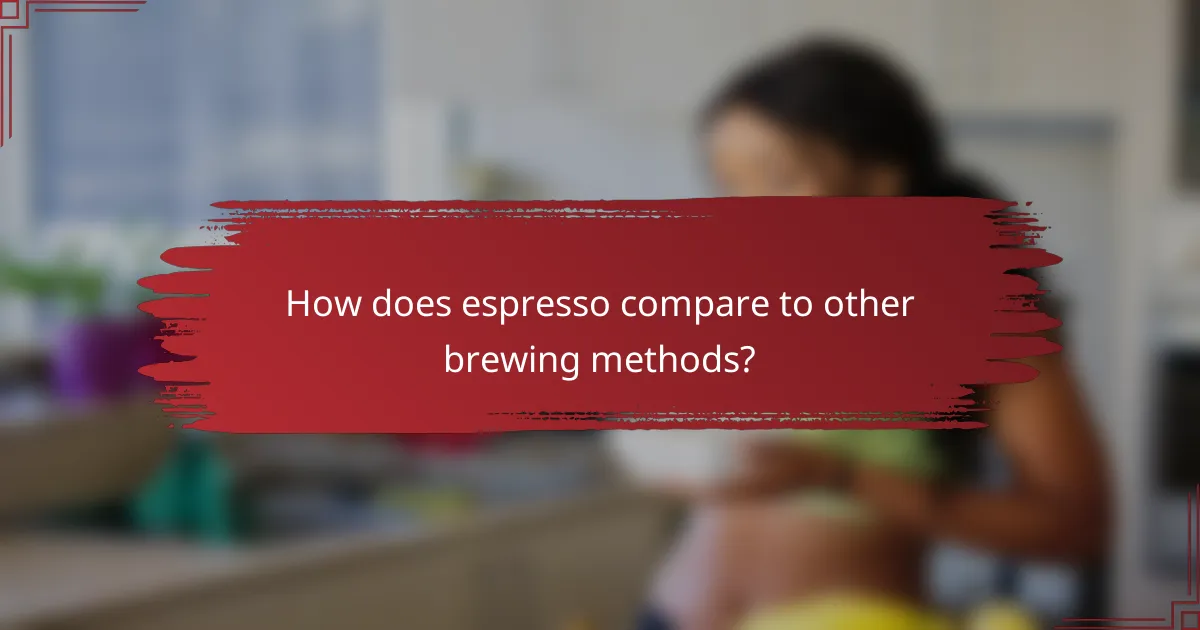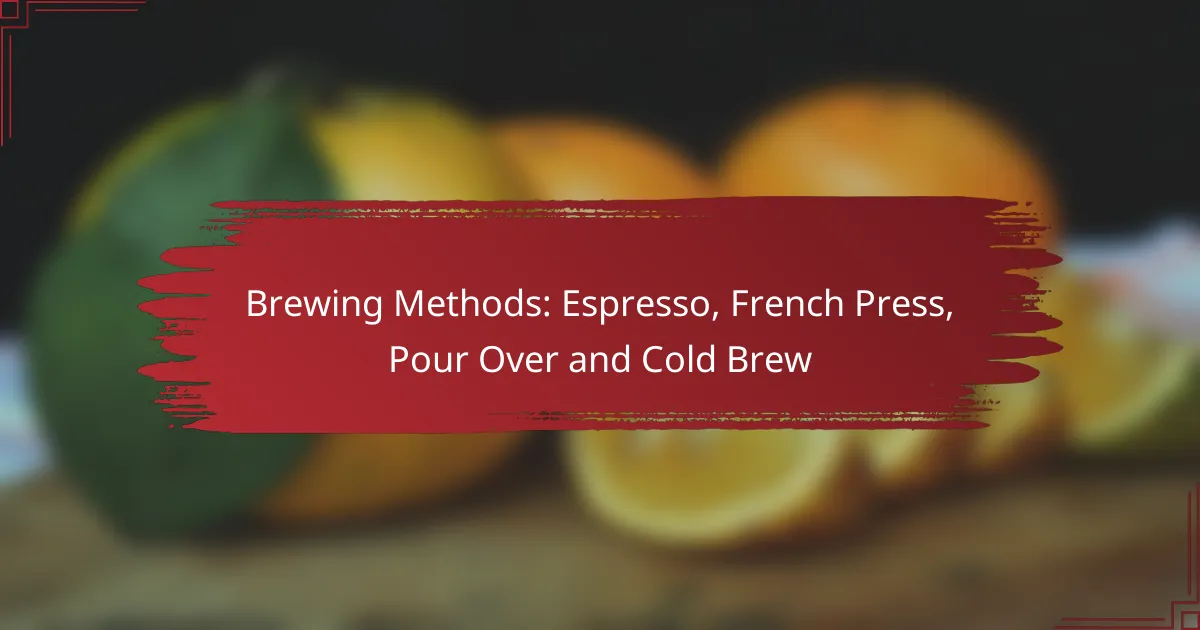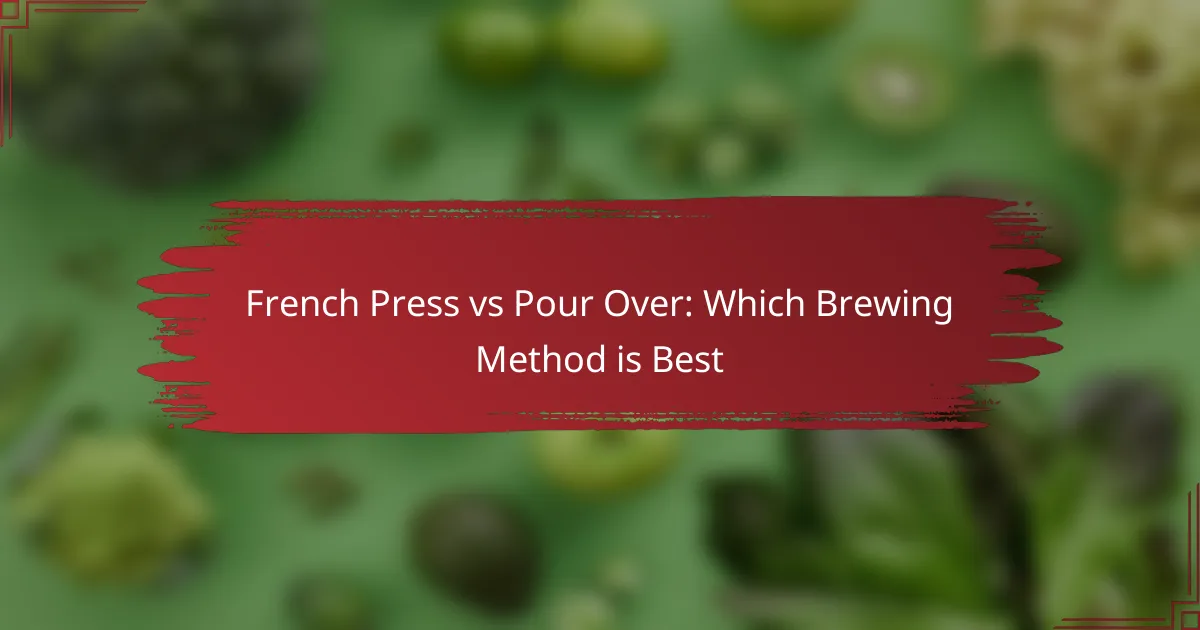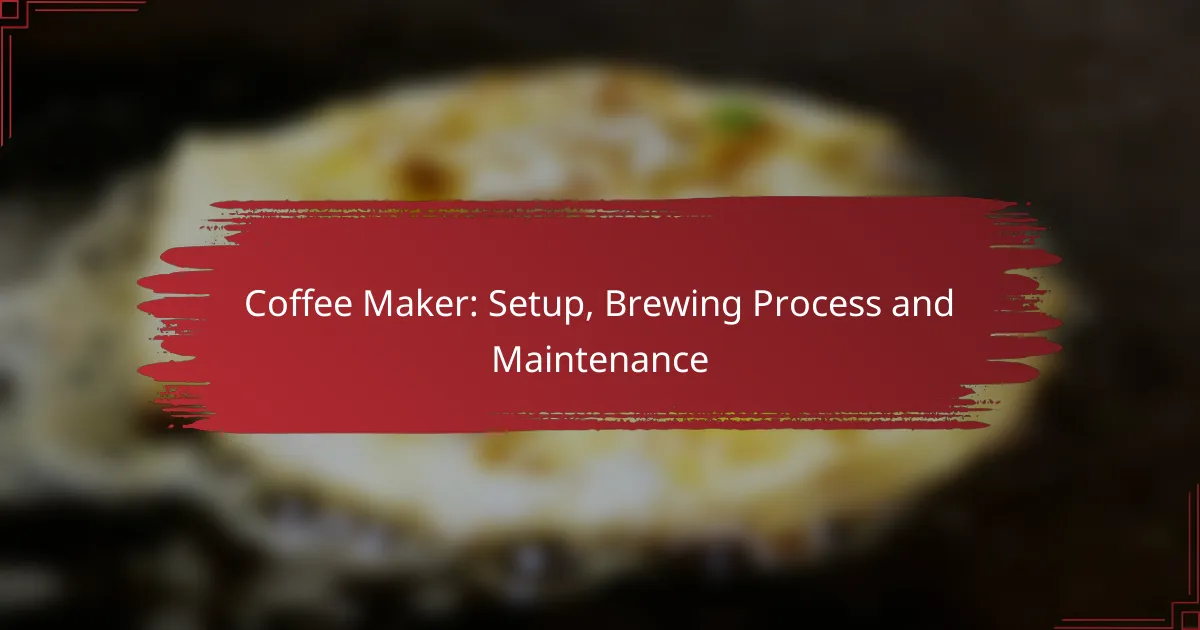Exploring various coffee brewing methods reveals a world of flavors and experiences, with espresso, French press, pour over, and cold brew standing out as popular choices. Each technique offers distinct characteristics that influence the taste, strength, and preparation time, catering to diverse preferences among coffee lovers. By understanding the unique qualities and equipment required for each method, you can enhance your coffee brewing journey.

What are the best brewing methods for coffee?
The best brewing methods for coffee include espresso, French press, pour over, and cold brew. Each method has unique characteristics that affect flavor, strength, and preparation time, allowing coffee enthusiasts to choose based on their preferences.
Espresso brewing method
Espresso is a concentrated coffee brewed by forcing hot water through finely-ground coffee under high pressure. This method produces a rich, bold flavor and a creamy texture, making it the base for many coffee drinks like lattes and cappuccinos.
To brew espresso, you’ll need an espresso machine and finely ground coffee, typically using a coffee-to-water ratio of about 1:2. A standard shot takes around 25-30 seconds to extract, resulting in a volume of about 30-40 ml.
Common pitfalls include using coffee that is too coarse or not tamping it evenly, which can lead to under-extraction and a sour taste. Ensure your equipment is clean and properly calibrated for the best results.
French Press brewing method
The French press method involves steeping coarsely ground coffee in hot water for several minutes before pressing down a metal or plastic plunger to separate the grounds. This technique allows for full extraction of oils and flavors, resulting in a robust and aromatic cup.
For optimal brewing, use a coffee-to-water ratio of about 1:15 and steep for around 4 minutes. After pressing, serve immediately to avoid over-extraction, which can make the coffee bitter.
A common mistake is using water that is too hot, which can scorch the coffee. Aim for water temperatures between 90-96°C (194-205°F) for the best flavor extraction.
Pour Over brewing method
Pour over brewing is a manual method where hot water is poured over coffee grounds in a filter, allowing gravity to extract flavors as the water passes through. This technique offers control over brewing time and water flow, resulting in a clean and nuanced cup.
Use a coffee-to-water ratio of about 1:16 and pour in a slow, circular motion for even saturation. Brew time typically ranges from 2.5 to 4 minutes, depending on the grind size and coffee type.
Be cautious of using too fine a grind, which can lead to clogging and uneven extraction. Experiment with different pouring techniques to find the flavor profile you enjoy most.
Cold Brew brewing method
Cold brew coffee is made by steeping coarsely ground coffee in cold water for an extended period, usually 12-24 hours. This method results in a smooth, less acidic beverage that can be served over ice or mixed with milk or sweeteners.
For cold brew, a common ratio is 1:4 coffee to water, steeped in the refrigerator. After steeping, strain the mixture through a fine mesh or coffee filter to remove grounds.
A frequent error is using water that is too warm, which can lead to over-extraction. Keep the brewing process cool to maintain the desired flavor profile and avoid bitterness.

How does espresso compare to other brewing methods?
Espresso is a concentrated coffee brewed by forcing hot water through finely-ground coffee under pressure, distinguishing it from other methods like French Press, Pour Over, and Cold Brew. Each method offers unique flavors, brewing times, and equipment requirements, making them suitable for different preferences and occasions.
Espresso vs French Press
Espresso and French Press differ primarily in brewing technique and flavor profile. While espresso uses high pressure to extract flavors quickly, French Press relies on steeping coarsely ground coffee in hot water for several minutes, resulting in a fuller-bodied coffee with more oils and sediment.
In terms of preparation, espresso typically takes about 25-30 seconds to brew, while French Press requires around 4 minutes. This difference affects the taste; espresso is intense and concentrated, whereas French Press coffee tends to be smoother and more robust.
Espresso vs Pour Over
Espresso and Pour Over methods both emphasize flavor extraction but achieve it differently. Espresso uses pressure and fine grounds for a quick brew, while Pour Over involves a slower, manual process where hot water is poured over medium to coarse grounds, allowing for more control over extraction time and temperature.
The resulting flavors also vary; espresso is rich and bold, while Pour Over can highlight subtle notes and acidity. Brew time for Pour Over generally ranges from 2 to 4 minutes, depending on the pour technique, making it a more leisurely process compared to espresso.
Espresso vs Cold Brew
Espresso and Cold Brew are distinct in both brewing methods and flavor characteristics. Espresso is brewed hot and quickly, while Cold Brew involves steeping coarsely ground coffee in cold water for an extended period, typically 12 to 24 hours, resulting in a smooth, less acidic coffee.
Cold Brew is often served over ice and can be diluted with water or milk, making it refreshing, especially in warmer climates. In contrast, espresso is served hot or as a base for various coffee drinks, offering a more intense flavor experience in a smaller volume.

What equipment is needed for each brewing method?
Each brewing method requires specific equipment to achieve the best flavor and extraction. Understanding the necessary tools for espresso, French press, pour over, and cold brew will help you make informed choices for your coffee brewing experience.
Equipment for Espresso
To brew espresso, you need an espresso machine, which can range from manual to fully automatic models. A quality grinder is essential for achieving the fine grind required for espresso, as well as a tamper to compress the coffee grounds evenly.
Consider investing in a scale to measure coffee and water accurately, as precision is key in espresso preparation. Additionally, a milk frother is useful if you enjoy lattes or cappuccinos.
Equipment for French Press
The French press requires a French press pot, which consists of a cylindrical glass or stainless steel container and a plunger with a mesh filter. Coarse coffee grounds are ideal for this method, so a grinder that can produce a consistent coarse grind is necessary.
You will also need hot water, ideally just off the boil, and a timer to ensure proper steeping time, usually around four minutes. A scale can help measure the coffee-to-water ratio, typically around 1:15 for optimal flavor.
Equipment for Pour Over
For pour over coffee, you need a pour over brewer, such as a Chemex or a V60, along with a coffee filter that fits your chosen brewer. A gooseneck kettle is recommended for precise pouring control, which helps in evenly saturating the coffee grounds.
A scale is beneficial for measuring coffee and water accurately, with a common ratio of 1:16. A grinder that can produce a medium-fine grind is also important for achieving the best extraction.
Equipment for Cold Brew
Cold brew requires a cold brew maker or a large jar for steeping coffee grounds. Coarse coffee grounds are essential, so a grinder that can produce this consistency is needed. You will also need cold or room temperature water for the brewing process.
Typically, a coffee-to-water ratio of 1:4 to 1:8 is used, depending on how strong you want the final brew. A strainer or cheesecloth is necessary to filter out the coffee grounds after steeping, which usually takes 12 to 24 hours in the refrigerator or at room temperature.

What are the key differences in flavor profiles?
The flavor profiles of brewing methods like espresso, French press, pour over, and cold brew vary significantly due to differences in extraction time, grind size, and brewing temperature. Each method highlights unique characteristics of the coffee beans, resulting in distinct taste experiences.
Flavor profile of Espresso
Espresso is known for its rich, bold flavor and creamy texture, often featuring a layer of crema on top. The high pressure used during extraction intensifies the coffee’s natural sweetness and acidity, resulting in a concentrated shot that can have chocolatey, nutty, or fruity notes.
Typically, a single shot of espresso is around 30-40 ml and is brewed in about 25-30 seconds. This quick extraction time captures the essence of the coffee while minimizing bitterness.
Flavor profile of French Press
The French press method produces a full-bodied coffee with a robust flavor profile, as the coffee grounds steep directly in hot water. This immersion brewing allows for a longer extraction time, usually around 4 minutes, which can bring out earthy and herbal notes.
Due to the coarser grind and the presence of coffee oils, French press coffee often has a heavier mouthfeel compared to other methods. Users should be cautious not to over-steep, as this can lead to excessive bitterness.
Flavor profile of Pour Over
Pour over coffee offers a clean and bright flavor profile, emphasizing the coffee’s acidity and floral notes. The method involves a controlled pour of hot water over the coffee grounds, allowing for precise extraction and highlighting the coffee’s unique characteristics.
Brewing time for pour over typically ranges from 2 to 4 minutes, depending on the grind size and water temperature. A medium grind is recommended to balance extraction and clarity, avoiding overly bitter or sour flavors.
Flavor profile of Cold Brew
Cold brew coffee is characterized by its smooth, mellow taste with low acidity, making it a popular choice for those sensitive to acidity. The brewing process involves steeping coarsely ground coffee in cold water for an extended period, usually 12 to 24 hours.
This method extracts different flavor compounds than hot brewing, often resulting in chocolatey, sweet, and nutty flavors. Cold brew can be served straight or diluted with water or milk, depending on personal preference.

How do brewing times affect coffee taste?
Brewing times significantly influence the taste of coffee by determining the extraction of flavors from the coffee grounds. Shorter brewing times can lead to under-extraction, resulting in a sour taste, while longer times may cause over-extraction, leading to bitterness.
Brewing time for Espresso
Espresso typically requires a brewing time of about 25 to 30 seconds. This short duration allows for a concentrated extraction of flavors, resulting in a rich and bold taste. The pressure used during brewing also plays a crucial role in achieving the desired flavor profile.
To ensure optimal extraction, use finely ground coffee and monitor the brewing time closely. A common pitfall is using too coarse a grind or brewing for too long, which can lead to undesirable bitterness.
Brewing time for French Press
For French Press, the recommended brewing time is around 4 to 5 minutes. This duration allows the coffee grounds to steep adequately, extracting a full range of flavors while avoiding over-extraction. Coarse coffee grounds are ideal for this method to prevent clogging the filter.
Be cautious not to exceed the brewing time, as it can lead to a bitter taste. A good practice is to set a timer and stir the grounds briefly after adding hot water to ensure even saturation.
Brewing time for Pour Over
Pour Over coffee generally takes about 2 to 4 minutes to brew, depending on the desired strength and the grind size. This method allows for precise control over the brewing process, enabling a balanced extraction of flavors. A medium grind is typically recommended for optimal results.
To achieve the best taste, pour water in a slow, circular motion, ensuring all grounds are saturated evenly. Avoid rushing the process, as a quick pour can lead to uneven extraction and a less flavorful cup.


